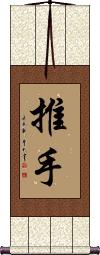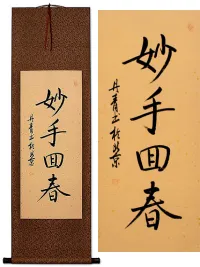Many custom options...
And formats...

Pushing Hands Tui Sau in Chinese / Japanese...
Buy a Pushing Hands Tui Sau calligraphy wall scroll here!
Personalize your custom “Pushing Hands Tui Sau” project by clicking the button next to your favorite “Pushing Hands Tui Sau” title below...
Pushing Hands / Tui Sau
推手 is the martial arts title “Pushing Hands.”
推手 is the title for two-person training routines practiced in internal Chinese martial arts such as Baguazhang, Xingyiquan, Tai Chi Chuan (Taijiquan), Liuhebafa, Chuan Fa, and Yiquan.
The first character means “pushing.”
The second character means “hand” (or “hands”).
This term can be romanized as “Tui Sau,” “Tui Sao,” or from Mandarin, “Tui Shou.”
If you are looking for this term, chances are, you already know the meaning within the context of Tai Chi and other martial arts.
Push or Knock
To weigh one's words
During the Tang Dynasty, a man named Jia Dao (born in the year 779), a well-studied scholar and poet, went to the capital to take the imperial examination.
One day as he rides a donkey through the city streets, a poem begins to form in his mind. A portion of the poem comes into his head like this:
“The bird sits on the tree branch near a pond,
A monk approaches and knocks at the gate...”
At the same time, he wondered if the word “push” would be better than “knock” in his poem.
As he rides down the street, he imagines the monk pushing or knocking. Soon he finds himself making motions of pushing and shaking a fist in a knocking motion as he debates which word to use. He is quite a sight as he makes his way down the street on his donkey with hands and fists flying about as the internal debate continues.
As he amuses people along the street, he becomes completely lost in his thoughts and does not see the mayor's procession coming in the opposite direction. Jia Bao is blocking the way for the procession to continue down the road, and the mayor's guards immediately decide to remove Jia Bao by force. Jia Bao, not realizing that he was in the way, apologizes, explains his poetic dilemma and awaits his punishment for blocking the mayor's way.
The mayor, Han Yu, a scholar and author of prose himself, finds himself intrigued by Jia Dao's poem and problem. Han Yu gets off his horse and addresses Jia Bao, stating, “I think knock is better.” The relieved Jia Bao raises his head and is invited by the mayor to join the procession, and are seen riding off together down the street, exchanging their ideas and love of poetry.
In modern Chinese, this 反復推敲 idiom is used when someone is trying to decide which word to use in their writing or when struggling to decide between two things when neither seems to have a downside.
This in-stock artwork might be what you are looking for, and ships right away...
Gallery Price: $200.00
Your Price: $95.88
Not the results for Pushing Hands Tui Sau that you were looking for?
Below are some entries from our dictionary that may match your Pushing Hands Tui Sau search...
| Characters If shown, 2nd row is Simp. Chinese |
Pronunciation Romanization |
Simple Dictionary Definition |
推手 see styles |
tuī shǒu tui1 shou3 t`ui shou tui shou |
More info & calligraphy: Pushing Hands / Tui Sau |
押出し see styles |
oshidashi おしだし |
(1) pushing something out; presence; (2) appearance; (3) (baseb) run walked in; (4) (sumo) pushing one's opponent out by pressing one's hands up against them |
筈押し see styles |
hazuoshi はずおし |
(sumo) pushing up with hands under opponent's armpits; armpit push |
はず押し see styles |
hazuoshi はずおし |
(sumo) pushing up with hands under opponent's armpits; armpit push |
押し出し see styles |
oshidashi おしだし |
(1) pushing something out; presence; (2) appearance; (3) (baseb) run walked in; (4) (sumo) pushing one's opponent out by pressing one's hands up against them |
Variations: |
hazuoshi はずおし |
{sumo} pushing up with hands under opponent's armpits; armpit push |
Variations: |
oshidashi おしだし |
(1) pushing something out; extrusion; (2) presence; appearance; (3) {baseb} run walked in; (4) {sumo} pushing one's opponent out by pressing one's hands up against them |
The following table may be helpful for those studying Chinese or Japanese...
| Title | Characters | Romaji (Romanized Japanese) | Various forms of Romanized Chinese | |
| Pushing Hands Tui Sau | 推手 | tuī shǒu / tui1 shou3 / tui shou / tuishou | t`ui shou / tuishou / tui shou | |
| Push or Knock | 反復推敲 反复推敲 | fǎn fù tuī qiāo fan3 fu4 tui1 qiao1 fan fu tui qiao fanfutuiqiao | fan fu t`ui ch`iao fanfutuichiao fan fu tui chiao |
|
| In some entries above you will see that characters have different versions above and below a line. In these cases, the characters above the line are Traditional Chinese, while the ones below are Simplified Chinese. | ||||
Successful Chinese Character and Japanese Kanji calligraphy searches within the last few hours...







